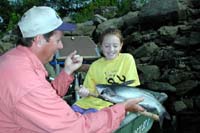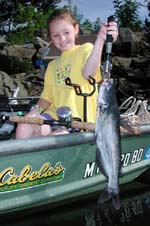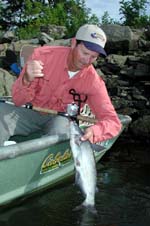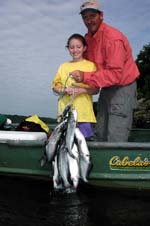
|
Features
|
|
|
|
Books
|
|
|
|
Fun & Games
|
|
|
|
Contact Us
|
|
|
John's Journal... Entry 254, Day 2
HOW TO FISH SUMMERTIME CATFISH
Large River Cats
 Editor's
Note: "Don't want no bream or crappie, Only one fish that makes me happy:
Catfish, catfish." (Taken from the musical "Pumpboys & Dinettes") Plenty
of anglers across the U.S. share the sentiments of this song from "Pumpboys
and Dinettes." They love the fun of matching baits to the seasons of the
year and the places where they fish to catch cats, and they enjoy the
delicious white meat of catfish. Although many anglers believe that throwing
a stink bait out on the bottom of any river in the summer will catch catfish,
to consistently take more cats on every outing, you need to know where
the fish most likely will occur, what they will eat in these spots, and
what conditions will cause them to feed most actively. You can check with
biologists, local anglers and area sporting-goods stores to learn what
catfish prefer to eat in your part of the state at each time of the year.
Several factors affect when and what catfish eat. The temperature of the
water governs how actively catfish feed because the enzyme action in a
catfish's stomach doubles with each 8-degree increase in water temperature.
The hotter the weather becomes, the more catfish feed. Since most catfish
prefer a dark habitat, they eat mostly at night during the hottest, sunniest
weather. My friend, Phil King of Corinth, Mississippi, an expert angler
and guide for catfish who primarily fishes Pickwick Lake on the Alabama/Mississippi/Tennessee
border, says that during the summer you'll most likely catch big catfish
an hour or two after daylight with the secondary peak time from 8:30 a.m.
until 10:30 a.m.
Editor's
Note: "Don't want no bream or crappie, Only one fish that makes me happy:
Catfish, catfish." (Taken from the musical "Pumpboys & Dinettes") Plenty
of anglers across the U.S. share the sentiments of this song from "Pumpboys
and Dinettes." They love the fun of matching baits to the seasons of the
year and the places where they fish to catch cats, and they enjoy the
delicious white meat of catfish. Although many anglers believe that throwing
a stink bait out on the bottom of any river in the summer will catch catfish,
to consistently take more cats on every outing, you need to know where
the fish most likely will occur, what they will eat in these spots, and
what conditions will cause them to feed most actively. You can check with
biologists, local anglers and area sporting-goods stores to learn what
catfish prefer to eat in your part of the state at each time of the year.
Several factors affect when and what catfish eat. The temperature of the
water governs how actively catfish feed because the enzyme action in a
catfish's stomach doubles with each 8-degree increase in water temperature.
The hotter the weather becomes, the more catfish feed. Since most catfish
prefer a dark habitat, they eat mostly at night during the hottest, sunniest
weather. My friend, Phil King of Corinth, Mississippi, an expert angler
and guide for catfish who primarily fishes Pickwick Lake on the Alabama/Mississippi/Tennessee
border, says that during the summer you'll most likely catch big catfish
an hour or two after daylight with the secondary peak time from 8:30 a.m.
until 10:30 a.m.
 "What
are those white things floating on the surface of the water?" I asked
John Hill, my friend who fishes the Tennessee River regularly. Hill answered,
"Those are Asiatic clams. Each summer these clams will have a die-off,
which signals a catfish bonanza. The catfish will move in and feed on
these mollusks as they begin to die. If you'll pick up some of these clams
off the surface, put them on a No. 1 hook, add a piece of shot lead 8
inches up the line, and let the clams float back down to the bottom, you'll
catch all the catfish you want."
"What
are those white things floating on the surface of the water?" I asked
John Hill, my friend who fishes the Tennessee River regularly. Hill answered,
"Those are Asiatic clams. Each summer these clams will have a die-off,
which signals a catfish bonanza. The catfish will move in and feed on
these mollusks as they begin to die. If you'll pick up some of these clams
off the surface, put them on a No. 1 hook, add a piece of shot lead 8
inches up the line, and let the clams float back down to the bottom, you'll
catch all the catfish you want."
 You
also can use your depth finder in a large river to locate big, underwater
boulders and underwater drop-offs and ledges that only may drop from 3
to 5 feet. These current breaks out in the middle of a river often will
hold numbers of catfish because they provide an ambush point for the catfish
and a current break where the fish can hold. Catfish also will concentrate
on the inside bends of main rivers. Too, I enjoy finding river cats where
small run-offs pour into the main river. Sometimes after a summer storm,
little feeder creeks and streams will bring mud-stained water with an
abundance of insects, worms, grubs and microorganisms into the river.
The baitfish will concentrate on the edges of the mud line. In these kinds
of places, the catfish have the option of feeding on the food brought
in by the running water or the baitfish attracted to that stained water.
Often within an hour after a run-off begins, catfish will stack-up in
these types of areas.
You
also can use your depth finder in a large river to locate big, underwater
boulders and underwater drop-offs and ledges that only may drop from 3
to 5 feet. These current breaks out in the middle of a river often will
hold numbers of catfish because they provide an ambush point for the catfish
and a current break where the fish can hold. Catfish also will concentrate
on the inside bends of main rivers. Too, I enjoy finding river cats where
small run-offs pour into the main river. Sometimes after a summer storm,
little feeder creeks and streams will bring mud-stained water with an
abundance of insects, worms, grubs and microorganisms into the river.
The baitfish will concentrate on the edges of the mud line. In these kinds
of places, the catfish have the option of feeding on the food brought
in by the running water or the baitfish attracted to that stained water.
Often within an hour after a run-off begins, catfish will stack-up in
these types of areas.
 To
take river cats in the summer, travel the middle of the river, and watch
your depth finder. You'll notice most of the fish you see in the middle
of the river will hold in about the same depth of water. Anchor upstream
of the school. Use a slip bobber to set the depth at which you'll fish,
and then bait. You often can locate catfish in little puddles in a large
river. Often a small funnel of water trickling from the main river into
a small pond, a drainage ditch or a side creek will hold catfish that
use these small channels to get into these backwater regions. Because
these areas seldom have fishing pressure, you may can pinpoint high concentrations
of catfish in these out-of-the-way places. You'll consistently produce
catfish where shallow flats break off into the main river channel, especially
after dark in the summertime. The catfish often will move up to the lip
of the break or even into the shallow water to feed when the stars come
out. By fishing with a float to keep your bait just off the bottom or
by using an egg-shaped slip sinker with a barrel swivel, 20 inches of
leader and a No. 6 hook on the bottom, you can catch the catfish as they
move onto the flats.
To
take river cats in the summer, travel the middle of the river, and watch
your depth finder. You'll notice most of the fish you see in the middle
of the river will hold in about the same depth of water. Anchor upstream
of the school. Use a slip bobber to set the depth at which you'll fish,
and then bait. You often can locate catfish in little puddles in a large
river. Often a small funnel of water trickling from the main river into
a small pond, a drainage ditch or a side creek will hold catfish that
use these small channels to get into these backwater regions. Because
these areas seldom have fishing pressure, you may can pinpoint high concentrations
of catfish in these out-of-the-way places. You'll consistently produce
catfish where shallow flats break off into the main river channel, especially
after dark in the summertime. The catfish often will move up to the lip
of the break or even into the shallow water to feed when the stars come
out. By fishing with a float to keep your bait just off the bottom or
by using an egg-shaped slip sinker with a barrel swivel, 20 inches of
leader and a No. 6 hook on the bottom, you can catch the catfish as they
move onto the flats.
To learn more about Phil King and his fishing and guide service, you can call him at (662) 286-8644, e-mail him at pking@tsixroads.com, or go to www.h2ow.com/catfish/. For more information about catching catfish, order John E. Phillips' book, "The Masters' Secrets of Catfishing," at www.nighthawkpublications.com/fishing/masterscatfish.htm. To learn more about fishing below the dam at Pickwick, contact the Hardin County Convention and Visitor’s Bureau at info@tourhardincounty.org, call 731-925-8181 or 800-552-3866, or visit www.tourhardincounty.org. Pickwick Landing State Park offers fishing, boating, hiking, camping, swimming and golf. Lodging includes the lakeside inn with over 100 rooms, cabins that sleep eight and a campground that contains 48 sites with grill and electric/water hookup at each site. A restaurant at the park offers delicious southern cuisine. Call 731-689-3135 or 800-250-8615 to learn more.
TOMORROW: BELOW DAMS AND IN MAIN LAKES
Check back each day this week for more about HOW TO FISH SUMMERTIME CATFISH ...
Day 1 - Small Streams And
Little Rivers
Day 2 - Large River Cats
Day 3 - Below Dams and in Main Lakes
Day 4 - Main Lakes and at Various Depths
Day 5 - What Cats Like